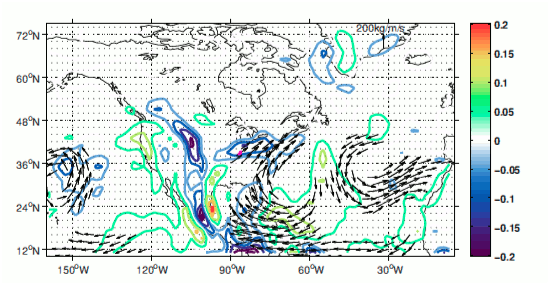It is critical for scientists to develop a better understanding of the structure and predictability of the specific climate factors that lead to extreme floods, especially in an era of human-caused climate change. Such an understanding is an important step toward making global forecasts that could be used for risk mitigation.
Development of a Dynamic Flood Forecasting Model Based on Large Scale Climatic Information
Various climate change projections suggest an intensification of precipitation in the future, in terms of both frequency and magnitude. Research conducted over the past two decades by Earth Institute scientists and others provides the basis for a new generation of prediction, forecasting and solutions to mitigate flood damage. Global climate patterns that can affect where and when extreme floods will occur include El Nino/La Nina-Southern Oscillation (ENSO), the Pacific Decadal Oscillation (PDO) and other “climate precursors” such as ocean temperatures, or the amount of regional snowpack. In addition, the smaller-scale, local hydrometeorology link between hydrology, surface water and the atmosphere, allows scientists to take such factors as soil moisture, forest cover or local irrigation practices into account. Understanding how the particular confluence of these factors makes an extreme flood more or less likely is the key to helping prepare for floods and mitigate their damage.

The Predictability of Extreme Floods
Recent extreme floods in the United States (1993, 2011), China (1998), United Kingdom (2000, 2003), Pakistan (2010), Europe (1995, 2010) and Thailand (2011) highlight the importance of understanding the hydro-meteorological processes responsible for these extreme flood events and the associated temporal and spatial characteristics of sequences for the associated precipitation events.
Recent research offers the potential for a better understanding of how floods cluster in time and space, along with associated climate precursors. This new understanding provides novel opportunities for risk management through early warning and action, and financial instruments. Many of these opportunities are just emerging.
Current engineering and insurance risk analysis of annual maximum flood events relies on assumptions of stationarity (the past is representative of the future) and independence (the chance of getting a flood of a certain size at a given location in a given year does not depend on events in other specific years or on other known factors).
“Climate change” can be due to human-induced (anthropogenic) factors or due to slow or abrupt natural variations. In either case, instead of assuming stationarity as in the past, it is useful to think of a time varying or dynamic risk—risk that can change or vary markedly over time depending on the state of the climate at any given point. In other words, some periods have a higher flood risk because of natural climate fluctuations. CWC scientists have found that some of this risk is predictable given observed and projected conditions that drive changes.
Extreme floods are by definition rare events—yet the human impact of these events is both broad and long lasting
The growing impact of floods in recent decades arises from a confluence of factors, including increases in population and settlement in vulnerable areas, land use changes such as urbanization, deforestation and climate change. Floods are the world’s most prevalent natural disaster and a major contributor to the average annual loss of life and property globally. Recent floods in Thailand, Australia, Brazil, Pakistan, China, Sri Lanka and India highlight the continued damage floods cause for people around the world.

Extreme floods hit developing nations particularly hard— especially in the agricultural sector. In addition to initial loss of life and direct economic damage, floods can have long-term indirect consequences as well. A single flood event can knock low-income households below the poverty line, from which it is difficult to recover. Meanwhile, flood risk to farmers in developing nations can make it difficult to obtain loans, which in turn prevents investment in technology that could improve productivity and efficiency. For their part, governments pay in the form of disaster relief, infrastructure repair, lost revenues and lower economic growth.
